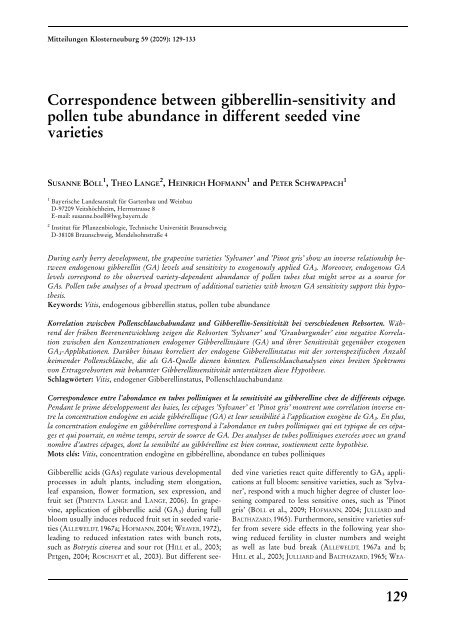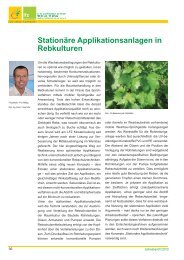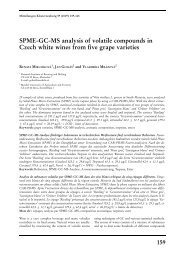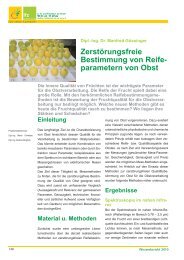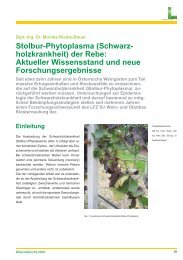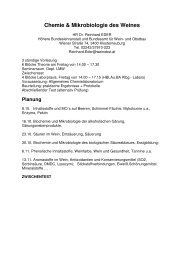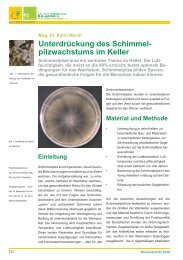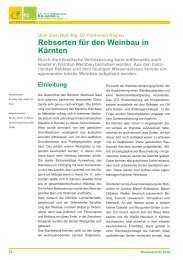Correspondence between gibberellin-sensitivity and pollen tube ...
Correspondence between gibberellin-sensitivity and pollen tube ...
Correspondence between gibberellin-sensitivity and pollen tube ...
Create successful ePaper yourself
Turn your PDF publications into a flip-book with our unique Google optimized e-Paper software.
Mitteilungen Klosterneuburg 59 (2009): 129-133<br />
<strong>Correspondence</strong> <strong>between</strong> <strong>gibberellin</strong>-<strong>sensitivity</strong> <strong>and</strong><br />
<strong>pollen</strong> <strong>tube</strong> abundance in different seeded vine<br />
varieties<br />
SUSANNE BOÈ LL 1 ,THEO LANGE 2 ,HEINRICH HOFMANN 1 <strong>and</strong> PETER SCHWAPPACH 1<br />
1 Bayerische L<strong>and</strong>esanstalt fuÈ r Gartenbau und Weinbau<br />
D-97209 VeitshoÈ chheim, Herrnstrasse 8<br />
E-mail: susanne.boell@lwg.bayern.de<br />
2 Institut fuÈ r Pflanzenbiologie, Technische UniversitaÈt Braunschweig<br />
D-38108 Braunschweig, Mendelsohnstraûe 4<br />
During early berry development, the grapevine varieties 'Sylvaner' <strong>and</strong> 'Pinot gris' show an inverse relationship <strong>between</strong><br />
endogenous <strong>gibberellin</strong> (GA) levels <strong>and</strong> <strong>sensitivity</strong> to exogenously applied GA 3 .Moreover, endogenous GA<br />
levels correspond to the observed variety-dependent abundance of <strong>pollen</strong> <strong>tube</strong>s that might serve as a source for<br />
GAs.Pollen <strong>tube</strong> analyses of a broad spectrum of additional varieties with known GA <strong>sensitivity</strong> support this hypothesis.<br />
Keywords: Vitis, endogenous <strong>gibberellin</strong> status, <strong>pollen</strong> <strong>tube</strong> abundance<br />
Korrelation zwischen Pollenschlauchabundanz und Gibberellin-SensitivitaÈt bei verschiedenen Rebsorten. WaÈhrend<br />
der fruÈ hen Beerenentwicklung zeigen die Rebsorten 'Sylvaner' und 'Grauburgunder' eine negative Korrelation<br />
zwischen den Konzentrationen endogener GibberellinsaÈure (GA) und ihrer SensitivitaÈt gegenuÈ ber exogenen<br />
GA 3 -Applikationen.DaruÈ ber hinaus korreliert der endogene Gibberellinstatus mit der sortenspezifischen Anzahl<br />
keimender PollenschlaÈuche, die als GA-Quelle dienen koÈ nnten.Pollenschlauchanalysen eines breiten Spektrums<br />
von Ertragsrebsorten mit bekannter GibberellinsensitivitaÈt unterstuÈ tzen diese Hypothese.<br />
SchlagwoÈ rter: Vitis, endogener Gibberellinstatus, Pollenschlauchabundanz<br />
<strong>Correspondence</strong> entre l'abondance en <strong>tube</strong>s polliniques et la sensitivite au <strong>gibberellin</strong>e chez de diffeÂrents ceÂpage.<br />
Pendant le prime deÂveloppement des baies, les ceÂpages 'Sylvaner' et 'Pinot gris' montrent une correÂlation inverse entre<br />
la concentration endogeÁne en acide gibbeÂrellique (GA) et leur sensibilite aÁ l'application exogeÁnedeGA 3 .En plus,<br />
la concentration endogeÁne en gibbeÂrelline correspond aÁ l'abondance en <strong>tube</strong>s polliniques qui est typique de ces ceÂpages<br />
et qui pourrait, en meÃme temps, servir de source de GA.Des analyses de <strong>tube</strong>s polliniques exerceÂes avec un gr<strong>and</strong><br />
nombre d'autres ceÂpages, dont la sensibilte au gibbeÂrelline est bien connue, soutiennent cette hypotheÁse.<br />
Mots cleÂs: Vitis, concentration endogeÁne en gibbeÂrelline, abondance en <strong>tube</strong>s polliniques<br />
Gibberellic acids (GAs) regulate various developmental<br />
processes in adult plants, including stem elongation,<br />
leaf expansion, flower formation, sex expression, <strong>and</strong><br />
fruit set (PIMENTA LANGE <strong>and</strong> LANGE, 2006). In grapevine,<br />
application of gibberellic acid (GA 3 ) during full<br />
bloom usually induces reduced fruit set in seeded varieties<br />
(ALLEWELDT, 1967a; HOFMANN, 2004; WEAVER, 1972),<br />
leading to reduced infestation rates with bunch rots,<br />
such as Botrytis cinerea <strong>and</strong> sour rot (HILL et al., 2003;<br />
PEtgen, 2004; ROSCHATT et al., 2003). But different seeded<br />
vine varieties react quite differently to GA 3 applications<br />
at full bloom: sensitive varieties, such as 'Sylvaner',<br />
respond with a much higher degree of cluster loosening<br />
compared to less sensitive ones, such as 'Pinot<br />
gris' (BOÈ LL et al., 2009; HOFMANN, 2004; JULLIARD <strong>and</strong><br />
BALTHAZARD, 1965). Furthermore, sensitive varieties suffer<br />
from severe side effects in the following year showing<br />
reduced fertility in cluster numbers <strong>and</strong> weight<br />
as well as late bud break (ALLEWELDT, 1967a <strong>and</strong> b;<br />
HILL et al., 2003; JULLIARD <strong>and</strong> BALTHAZARD, 1965; WEA-<br />
129
Mitteilungen Klosterneuburg 59 (2009): 129-133<br />
BoÈ ll et al.<br />
VER, 1960; WEAVER <strong>and</strong> MCCUNE, 1961).<br />
Early flowering <strong>and</strong> pollination processes are known to<br />
be directed by GA (PHARIS <strong>and</strong> KING, 1985; SINGH et al.,<br />
2002). High GA levels have been reported in <strong>pollen</strong> <strong>and</strong><br />
anthers of several monocotyledonous <strong>and</strong> dicotyledonous<br />
species. These GAs might not only be important<br />
for the pollination process itself, but might also regulate<br />
the subsequent ovule development (IZHAKI et al., 2002;<br />
PHARIS <strong>and</strong> KING, 1985). Thus, differences in endogenous<br />
GA levels of different varieties could be the cause<br />
for a different <strong>sensitivity</strong> towards exogenous GA applications.<br />
To test this hypothesis, endogenous GA levels<br />
in ovaries of two seeded varieties with known differences<br />
in <strong>gibberellin</strong>-<strong>sensitivity</strong>, 'Pinot gris' <strong>and</strong> 'Sylvaner'<br />
(BOÈ LL et al., 2009), were determined by GC-MS analyses<br />
during pre- <strong>and</strong> post-bloom development. In addition,<br />
<strong>pollen</strong> <strong>tube</strong> germination of these varieties together<br />
with nine additional varieties was quantified, <strong>and</strong> their<br />
potential impact on endogenous GA levels during early<br />
berry development is discussed.<br />
Material <strong>and</strong> Methods<br />
Gibberellin extraction <strong>and</strong> GC-MS analysis<br />
In 2006, berries of 'Sylvaner' <strong>and</strong> 'Pinot gris', grown in<br />
Franconian vineyards of the Bavarian State Institute<br />
for Viticulture <strong>and</strong> Horticulture, were collected <strong>and</strong> immediately<br />
frozen for quantitative determination of endogenous<br />
GAs. They were sampled at four developmental<br />
stages (pre-bloom (BBCH 61), post-bloom<br />
(BBCH 68), berries groat-sized (BBCH 73), berries begin<br />
to touch (BBCH 77) from seven to ten clusters to<br />
investigate GA levels of the two varieties over developmental<br />
time. Freeze-dried plant material (0.01 g <strong>and</strong><br />
0.1 g dry weight, respectively) was pulverized under liquid<br />
nitrogen <strong>and</strong> spiked with 17,17-d2-GA st<strong>and</strong>ards<br />
(1 ng each; purchased from Prof. L. M<strong>and</strong>er, Australian<br />
National University, Canberra, Australia). Samples<br />
were extracted, purified, derivatized, <strong>and</strong> analyzed by<br />
combined GC-MS using selected ion monitoring as described<br />
elsewhere (LANGE et al., 2005). Objective of this<br />
analysis were GA 20 , GA 1 <strong>and</strong> GA 8 , three successive<br />
GAs of the 13-hydroxylation <strong>gibberellin</strong> biosynthesis<br />
pathway, with GA 20 being the inactive precursor <strong>and</strong><br />
GA 8 the catabolic successor of the active plant hormone<br />
GA 1 .<br />
Pollen <strong>tube</strong> preparations<br />
In 2006, at full bloom (BBCH 65), ovaries of several<br />
clusters of 'Pinot gris' <strong>and</strong> 'Sylvaner', in 2008, ovaries<br />
of 40 clusters of these varieties <strong>and</strong> nine additional<br />
vine varieties were collected in the field <strong>and</strong> fixed in<br />
FAA solution (50 % ethanol:acetic acid:formalin =<br />
8:1:1 v/v/v). Additionally, for 'Sylvaner' <strong>and</strong> 'Pinot<br />
gris', ovaries from two different vineyards were collected<br />
to examine possible site effects.<br />
In the laboratory 20 ovaries of each variety <strong>and</strong> site<br />
were divided into half longitudinally, rinsed with tap<br />
water <strong>and</strong> stained with aniline blue for 24 hours (2.3<br />
gK 3 PO 4 in 100 ml aqua dest. + 0.1 g aniline blue).<br />
Thereafter, the specimens were rinsed twice with tap<br />
water, mounted on microslides in glycerine <strong>and</strong><br />
slightly squeezed. Pollen <strong>tube</strong>s in the styles of half<br />
ovaries were counted under a fluorescent microscope<br />
with blue light excitation. Data of the 2008 analyses<br />
were allotted to frequency categories <strong>and</strong> a category<br />
mean <strong>and</strong> st<strong>and</strong>ard error of the mean were calculated<br />
for each variety.<br />
Results<br />
GA analyses<br />
The two varieties 'Pinot gris' <strong>and</strong> 'Sylvaner' expressed<br />
striking differences in their endogenous GA levels: endogenous<br />
GA levels were high in 'Pinot gris' before<br />
(BBCH 61) <strong>and</strong> particularly high shortly after fertilization<br />
(BBCH 68 <strong>and</strong> BBCH 73; Fig. 1). Especially the<br />
accumulation of GA 8 , the catabolic product of the plant<br />
hormone GA 1 , is indicating a long lasting GA synthesis<br />
<strong>and</strong> high turnover rates in 'Pinot gris'. In contrast, endogenous<br />
GA levels <strong>and</strong> turnover rates of 'Sylvaner'<br />
were much lower (Fig. 1).<br />
Variety-dependent <strong>pollen</strong> <strong>tube</strong> abundance<br />
Preliminary <strong>pollen</strong> <strong>tube</strong> analyses of 'Sylvaner' <strong>and</strong> 'Pinot<br />
gris' in 2006 had shown striking differences in <strong>pollen</strong><br />
<strong>tube</strong> occurrence, with 'Pinot gris' ovaries displaying<br />
more than three times as many <strong>pollen</strong> <strong>tube</strong>s as ovaries<br />
of 'Sylvaner'. Comparable results were obtained for<br />
these varieties in 2008, without the vineyard site having<br />
any major effect. (Table 1). Altogether, the different<br />
studied varieties displayed a broad range of <strong>pollen</strong> <strong>tube</strong><br />
abundance (Table 1, Fig. 2) that correlates negatively<br />
with their known <strong>sensitivity</strong> towards GA 3 applications<br />
(Table 1).<br />
130
Mitteilungen Klosterneuburg 59 (2009): 129-133<br />
BoÈ ll et al.<br />
Discussion<br />
Figure 1: Endogenous <strong>gibberellin</strong> concentrations of the three consecutively metabolized gibberellic<br />
acids GA 20 ,GA 1 ,GA 8 of the 13-hydroxylation GA-pathway of <strong>gibberellin</strong> biosynthesis<br />
during early berry development of the varieties 'Sylvaner' (Syl) <strong>and</strong> 'Pinot<br />
gris' (PG)<br />
Figure 2: Pollen <strong>tube</strong> abundance in pistils of different varieties<br />
In the present study the<br />
known differential reactions<br />
of 'Sylvaner' <strong>and</strong><br />
'Pinot gris' to GA 3 application<br />
(BOÈ LL et al.,<br />
2009) correspond to the<br />
endogenous GA levels<br />
determined in these varieties:<br />
Compared to<br />
'Sylvaner' GA levels<br />
<strong>and</strong> turnover rates were<br />
much higher <strong>and</strong> longer<br />
lasting in developing<br />
berries of 'Pinot gris'<br />
indicating that exogenous<br />
GA applications<br />
might only have a minor<br />
impact on the hormone<br />
balance of 'Pinot<br />
gris' in contrast to the<br />
more GA sensitive variety.<br />
We suggest that the observed<br />
difference in the<br />
endogenous GA levels<br />
of the two varieties<br />
might be related to the<br />
variety-dependent abundance<br />
of <strong>pollen</strong> <strong>tube</strong>s<br />
in their pistils during<br />
bloom that, again,<br />
was found to be much<br />
higher in 'Pinot gris'<br />
than in 'Sylvaner'. During<br />
pre-bloom, high<br />
GA concentrations are<br />
predominantly found<br />
in anthers <strong>and</strong> <strong>pollen</strong>,<br />
as studies of various<br />
plant species have<br />
shown, that have an influence<br />
on <strong>pollen</strong> germination<br />
as well as on<br />
<strong>pollen</strong> <strong>tube</strong> growth<br />
<strong>and</strong> possibly on the<br />
subsequent ovule development<br />
(IZHAKI et al.,<br />
2002; PHARIS <strong>and</strong> KING,<br />
131
Mitteilungen Klosterneuburg 59 (2009): 129-133<br />
BoÈ ll et al.<br />
1985; SINGH et al., 2002). The results of the <strong>pollen</strong> <strong>tube</strong><br />
analyses of a broad spectrum of additional varieties<br />
with known GA <strong>sensitivity</strong> reported here strongly support<br />
our hypothesis: sensitive varieties such as 'Sylvaner',<br />
'Traminer' <strong>and</strong> 'Kerner' were found to have a distinctly<br />
lower <strong>pollen</strong> <strong>tube</strong> abundance than the less sensitive<br />
Pinot varieties. Only 'Riesling' is difficult to classify<br />
along these lines, as it exhibits differential <strong>gibberellin</strong><br />
sensitivities in different studies as well as at different<br />
sites (HILL et al., 2003; JULLIARD <strong>and</strong> BALTHAZARD, 1965;<br />
WALG, 2005), including moderate to strong side effects,<br />
that might depend on the cultivated clone. Furthermore,<br />
'Riesling' responds to GA applications with an<br />
increase instead of a thinning of the developing berries<br />
that are, however, much smaller than untreated berries<br />
due to induced parthenocarpy.<br />
Our results imply that a simple microscopic analysis of<br />
the <strong>pollen</strong> <strong>tube</strong> abundance of varieties with hitherto unknown<br />
<strong>gibberellin</strong> <strong>sensitivity</strong> might well indicate the<br />
endogenous GA status of a given variety which in turn<br />
is expected to predict the <strong>sensitivity</strong> to exogenous<br />
GA 3 -treatment including possible adverse side effects.<br />
Acknowledgements<br />
We would like to thank ANJA LIEBRANDT, MONIKAADEL-<br />
HARDT<strong>and</strong> ASTRID BAUMANN for their valuable technical<br />
assistance. We would also like to thank THOMAS JAR-<br />
CHAU for constructive comments on the manuscript.<br />
This work was supported by the Forschungsring Deutscher<br />
Weinbau (grant 8503.187)<br />
References<br />
ALLEWELDT, G. 1967a: Physiologie der Rebe. Forschungsergebnisse<br />
der Jahre 1956-1960. Vitis 6: 48-62<br />
ALLEWELDT, G. 1967b: Physiologie der Rebe. Forschungsergebnisse<br />
der Jahre 1961-1964. Vitis 6: 63-81<br />
BOÈ LL, S., HOFMANN, H. und SCHWAPPACH, P. 2009: Einsatz der<br />
Wachstumsregulatoren Gibb3 und Regalis - warum Sorten<br />
unterschiedlich reagieren. Rebe und Wein (5): 24-27<br />
HILL, G., HILL, M. und BUTTERFASS, J. 2003: Gibberelline - kleiner,<br />
weniger, besser? Dt. Weinmagazin (19): 32-35<br />
HILL, M. B. 2003: Chemische AusduÈ nnung und deren Auswirkung<br />
auf die Rebe. Unpublished diploma thesis, Geisenheim<br />
2003<br />
HOFMANN, H. 2004: Traubendesign zur FaÈulnispraÈvention.<br />
Rebe und Wein (5): 14-17<br />
IZHAKI, A., BOROCHOV, A., ZAMSKI, E. <strong>and</strong> WEISS, D. 2002: Gibberellin<br />
regulates post-microsporogenesis processes in<br />
petunia anthers. Physiologia plantarum 115: 442-447<br />
JULLIARD, B. et BALTHAZARD, J. 1965: Effets physiologiques de<br />
l'acide gibbeÂrellique sur quelques varieÂteÂs de vigne (Vitis<br />
vinifera L.). Ann. AmeÂlior. Plantes 15: 61-78<br />
KAST, W., FOX, R. und SCHIEFER, H.-C. 2005: Chancen und Risiken<br />
des Einsatzes von Gibb3. Rebe und Wein (5): 16-<br />
19<br />
LANGE, T., KAPPLER, J., FISCHER, A., FRISSE, A., PADEFFKE, T.,<br />
SCHMITTKE, S. <strong>and</strong> PIMENTA LANGE, M.J. 2005: Gibberellin<br />
biosynthesis in developing pumpkin seedlings. Plant<br />
Physiol. 139: 213-223<br />
PETGEN, M. 2004: Was bringen Gibberelline? Dt. Weinmagazin<br />
(3): 28-32<br />
PHARIS, R.P. <strong>and</strong> KING, R.W. 1985: Gibberellins <strong>and</strong> reproductive<br />
development in seed plants. Ann. Rev. Physiol. 36:<br />
517-568<br />
PIMENTA LANGE, M.J. <strong>and</strong> LANGE, T. 2006: Gibberellin biosynthesis<br />
<strong>and</strong> the regulation of plant development. Plant<br />
Biology 8: 281-290<br />
132
Mitteilungen Klosterneuburg 59 (2009): 129-133<br />
BoÈ ll et al.<br />
REGNER, F., EISENHELD, C. und STADLBAUER, A. 2002: Versuche<br />
zur chemischen BeerenausduÈ nnung bei Rebe. Mitt. Klosterneuburg<br />
52: 3-9<br />
ROSCHATT, C., HAAS, E. und PEDRI, U. 2003: Der Einsatz von<br />
Gibberellinen im Weinbau gegen EssigfaÈule. Obstbau<br />
Weinbau (4): 114-117<br />
SIEGFRIED, W. und JUÈ STRICH, H. 2008: Gibberellin-Versuche<br />
2007 im Rebbau. Schweiz. Z. Obst- und Weinbau<br />
144(10): 4-7<br />
SINGH, D.P., JERMAKOV, A.M. <strong>and</strong> SWAIN, S.M. 2002: Gibberellins<br />
are required for seed development <strong>and</strong> <strong>pollen</strong> <strong>tube</strong><br />
growth in Arabidosis. The Plant Cell 14: 1-15<br />
THEILER, R. 1977: Einsatz von Wachstumsregulatoren zur BekaÈmpfung<br />
der StiellaÈhme. Mitt. Klosterneuburg 27: 197-<br />
204<br />
WALG, O. 2005: Ertrag regulieren und Trauben gesund erhalten<br />
mit neuen Verfahren - Chance oder Risiko -. Dt. Weinbau-Jahrb.<br />
56: 39-48<br />
WEAVER, R.J. 1972: Plant growth substances in agriculture. -<br />
San Francisco: Freeman, 1972<br />
WEAVER, R.J. 1960: Toxicitiy of <strong>gibberellin</strong> to seedless <strong>and</strong> seeded<br />
varieties of Vitis vinifera. Nature 187: 1135-1136<br />
WEAVER, R.J. <strong>and</strong> McCune S.B. 1961: Effect of <strong>gibberellin</strong> on<br />
vine behavior <strong>and</strong> crop production in seeded <strong>and</strong> seedless<br />
Vitis vinifera. Hilgardia 30: 425-444<br />
WEYAND, K. <strong>and</strong> SCHULTZ, H. R. 2006: Regulating yield <strong>and</strong><br />
wine quality of minimal pruning systems through the application<br />
of gibberellic acid. J. Int. Sci. Vigne Vin 40(3):<br />
151-163<br />
Received August 13, 2009<br />
133


